- Quick Read
- Deep Read ( 13 Min. )
Monitor Daily Podcast
- Follow us:
- Apple Podcasts
- Spotify
- RSS Feed
- Download
TODAY’S INTRO
Her reporting brings in women’s perspectives
 April Austin
April Austin
During the time that Anna Mulrine Grobe covered the wars in Afghanistan and Iraq for the Monitor, she felt a special obligation to talk with the women in those countries. “So often when you’re covering these wars, it can be a guys’ story,” she says. “So it’s always been important to me to get the perspective of the other half of the population.”
For today’s lead story about Afghan refugees at a military base in Germany awaiting resettlement in the United States, Anna wanted to include not just how families as a whole were faring, but specifically how the women were doing. She spoke with Maj. Suzanne Stammler, an obstetrician in the U.S. Air Force, who was caring for new and expectant mothers. Dr. Stammler had never deployed to Afghanistan – “You don’t have troops having babies at war,” Anna says. So the doctor was surprised by many cultural aspects of working with Afghan women, from the husbands who answered questions for their wives to the young women who had already experienced multiple pregnancies.
Anna also felt an affinity for Afghan female refugees who were giving birth or about to give birth, “because I had gone through that so recently,” she says. “I had our second little one last year.” She continues, “You hope you can channel that into a few good details that help the reader get a sense of that picture, the plight of these women, their trepidation, and their determination.”
Share this article
Link copied.

Help fund Monitor journalism for $11/ month
Already a subscriber? Login

Monitor journalism changes lives because we open that too-small box that most people think they live in. We believe news can and should expand a sense of identity and possibility beyond narrow conventional expectations.
Our work isn't possible without your support.
A deeper look
For Afghan arrivals, a taste of the US at an air base in Germany
The first steps for people after fleeing a country can be daunting. Members of the U.S. military at Ramstein Air Base in Germany are trying to ease that transition for thousands of Afghans airlifted out of Kabul who are eventually headed to the U.S.
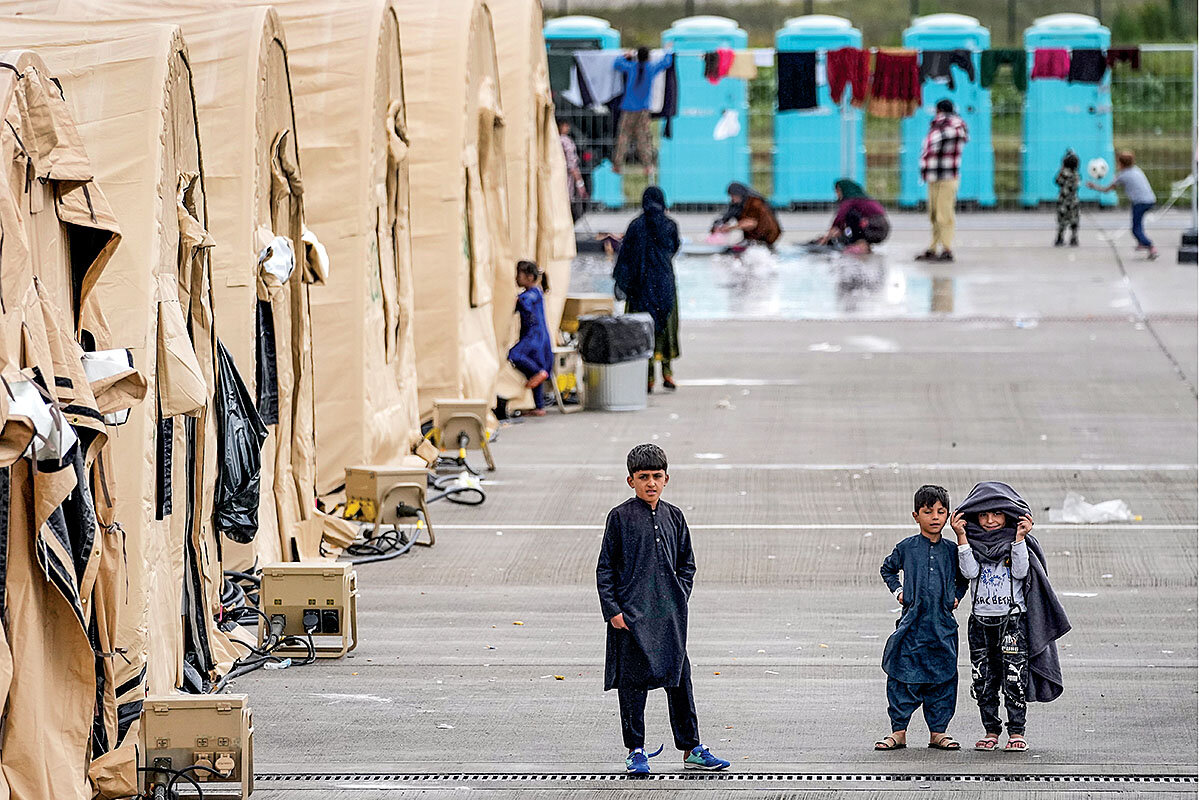
Fresh fruit. A bottle of water. And a smile. This may be a military base, but Afghans arriving at the United States’ Ramstein Air Base in Germany aren’t greeted by anyone in uniform, at least not at first.
Because these aren’t fighters, says Air Force Brig. Gen. Joshua Olson. “These are our future neighbors.”
But if the initial welcome went well, the prolonged hosting of thousands of refugees at the air base has also been full of taxing logistical hurdles. The sudden influx made handling basic necessities difficult. Trash removal, toilets, and kitchens struggled to keep up. Pregnant women and school-age children needed to be looked after. Uncertainty still hangs over many refugees, not sure how their future in the U.S. will play out.
Yet resilience shines through, as semblances of community emerge. Men who had been barbers in Afghanistan provide haircuts. Some 40 babies have been born in a gymnasium-turned-maternity ward. Children are learning English out of a hangar.
“How old are you?” asks Jessie Bledsoe, a military spouse teaching English at a class in the hangar. The classes were organized by Ahmad Faizi, a school director turned refugee at the base.
The little girl Ms. Bledsoe asked the question to responds: “I’m 10.”
The hangar erupts in cheers.
For Afghan arrivals, a taste of the US at an air base in Germany
In a dimly lit U.S. military tent, as tiny children toddle between benches, a group of Afghan women is getting a crash course in how to carry on in a new culture.
“Americans like to see people who are doing something,” the instructor tells them. “You can’t just sit on cushions and wait for things to come to you.”
Their future neighbors also don’t like people who are “judgy,” she warns, despite what they may have heard. “If you want to wear a headscarf, you can wear a headscarf. But if you want to be accepted, Americans also have a right to be accepted – their culture, their religion, everything. Don’t [be shocked] if you arrive and women are wearing much less.”
Other surprises will arise as they settle in, the instructor notes in the widely spoken Afghan language of Dari, starting with public buses and their predesignated stops. “It’s not like home, where you can tell the driver, ‘Let me off here.’”
A woman raises her hand. “I have questions.” The instructor tells her to hold on. “We’ll get to those later.”
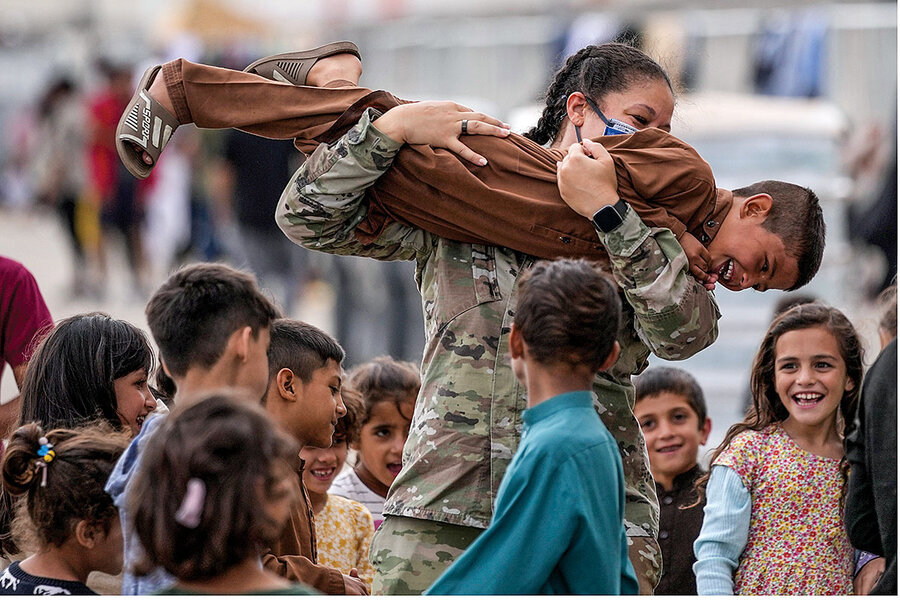
The women’s subsequent queries tend to involve what sort of reception they will receive in their new home – answers that will hinge on Americans themselves as they begin to welcome these Afghan allies, brought to safety in the largest air evacuation in U.S. military history.
The lessons being learned on this sprawling military base in Germany represent one more postscript to America’s tangled 20-year relationship with Afghanistan. After an abrupt end to America’s longest war and a shambolic evacuation, the U.S. military is now being faced with housing the thousands of Afghans who were airlifted out of the country and making them as comfortable as possible before they settle in the United States. That has meant setting up temporary maternity wards in gymnasiums, schools in hangars, and a small city of tents.
For the evacuees, the stay here at Ramstein Air Base, the largest military community overseas, is a way-stop to a future that is unknown from a past they knew they had to flee. While relieved to be out from under the Taliban’s repressive rule, many of the “travelers,” as they are known here, are struggling with guilt about loved ones still in the country. They are also wrestling with anxiety about how they will adjust to life in their new home and wondering what sort of treatment they will be greeted with upon their arrival.
That uncertainty is understandable. Americans continue to harbor some ambivalence about the newcomers. While three quarters of U.S. citizens (76% of Democrats and 74% of Republicans) support their resettlement in the U.S., according to a recent poll, a Republican proposal sought to cut off housing, food, and medical aid for Afghan immigrants by March 2023. It also endeavored to kill a provision that would allow them to get driver’s licenses without key documentation they may have left behind in their rush to flee the Taliban.
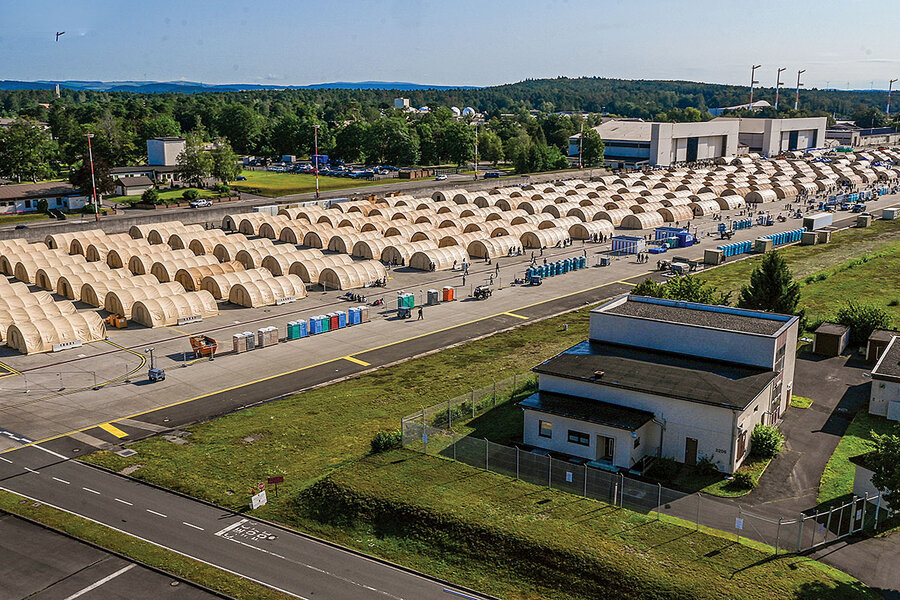
At the same time, former President Donald Trump urged his followers to oppose “free welfare” for Afghan refugees, who, he warned, would bring violence to U.S. shores “if this isn’t shut down.” The amendment in Congress was narrowly defeated along strict party lines, but could be reintroduced in future bills.
The precarity of future financial aid for the Afghans has been repeatedly hammered home in this class. But here at Ramstein, there is widespread gratitude among U.S. military personnel for the services Afghans provided during the war and a special sympathy for their plight. The majority of those who have arrived at the base, in numbers that reached 20,000 at their peak, worked directly with the U.S. in military, diplomatic, and development efforts, or are a family member of someone who did. Hundreds more were journalists or human rights activists, occupations that put them at risk and made them eligible to settle in the U.S. Others simply fled the country out of fear for their lives and were tough, or vulnerable, enough to make it on a flight.
To handle the influx, the military brought in nearly 1,000 service members from outside the region to help out the thousands of U.S. personnel at Ramstein. They’ve distributed 110 tons of donated clothes, assembled 542 tents big enough to hold about 30 people each, and played in daily soccer matches with the Afghans.
“This isn’t the Taliban,” says Air Force Brig. Gen. Joshua Olson, the top commander at Ramstein. “These are amazing people who are just coming from a different side of the world. These are our future neighbors.”
Even in the rush to find enough tents and food for Afghan evacuees, General Olson was clear on one thing: When the packed cargo planes landed, he didn’t want the new arrivals to be greeted by troops.
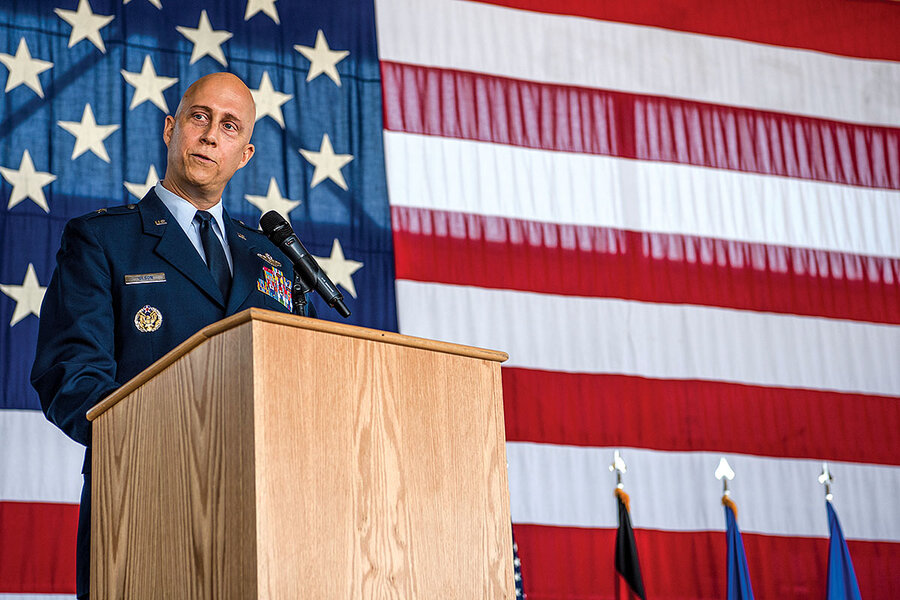
“Those folks were met with some fresh fruit, a bottle of water, and a smile – not a person in uniform,” he says, noting that the USO and Red Cross were among those doing the welcoming. “That was my focus.” They weren’t fighters, he says; they were family.
While the military is steeped in handling complex logistics, the sudden influx of new arrivals has produced its share of scrambling. The newcomers represent the largest surge of outsiders Ramstein has ever seen. While several military bases in the U.S. have received Afghan evacuees – some taking in as many as 13,000 – none has hosted the number of people in “little Kabul” here.
To house them all, the military quickly set up reserve tents – enough for 5,000 evacuees. But more than 6,500 Afghans arrived at Ramstein in the first couple of days alone. The troops also laid out thousands of cots, though they quickly learned that the evacuees didn’t like sleeping on them. So they tracked down 58,000 yoga mats instead, taking some out of storage, but purchasing most of them locally.
Finding enough food to suddenly feed a small village proved particularly difficult. “We bought up every ounce of food within 100 miles,” says the brigadier general. “We were buying out all the grocery stores and all of the restaurants on base, all the local bakeries.” But it still wasn’t enough, so they sent U.S. troops to Frankfurt Airport to snap up surplus airline meals.
This all created a lot of trash, and it wasn’t long before the sanitation troubles set in. For starters, water bottles ended up in the portable toilets, which were soon overflowing. “You can’t imagine the stench,” says General Olson.
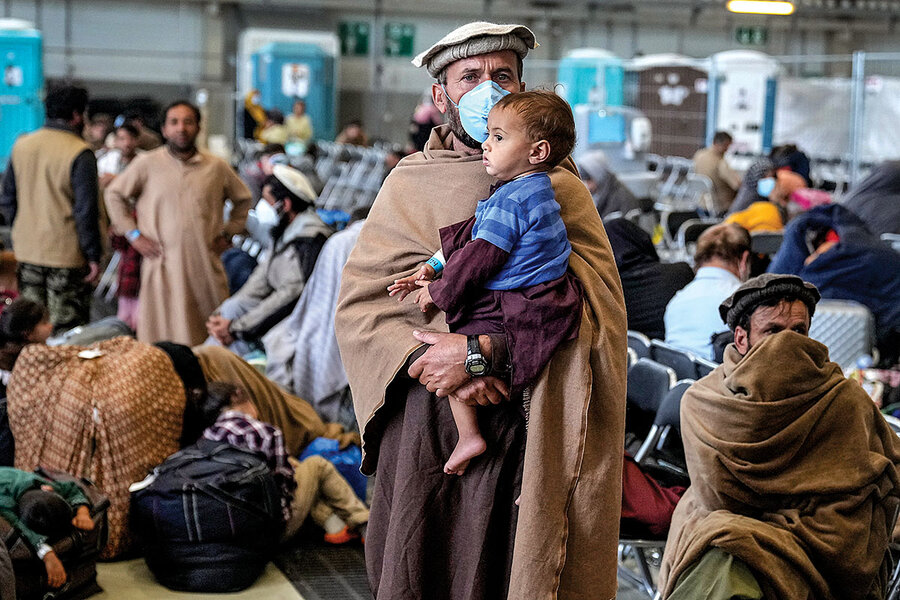
The bathroom troubles continued on commercial airliners commandeered to fly evacuees from Ramstein to the U.S. The planes were “gross” enough, he says, that private contractors refused to clean them, forcing the aircraft to be flown back to Ramstein full of human waste and garbage for U.S. troops to scour.
Families stepped up, too – more than 2,500 local Germans along with thousands of U.S. military spouses and children – to pick up trash around the airfield and volunteer in the two hangars cleared of planes to create space for the Afghans.
Service members also established a “kinder pod,” where they housed unaccompanied minors. One day, General Olson learned that there was a 23-year-old living in the pod. “I’m like ‘absolutely not,’” he recalls. “But then I heard her story.”
The young woman had been a college student in Kabul, but, worried about her future under the Taliban, she decided to flee. On her way to the airport, she picked up two small children whose parents had died. They all made it on the plane to Ramstein.
Proudly wearing her college T-shirt, the woman told UNICEF officials that she didn’t feel safe sleeping in the hangar: Other Afghans were bad-mouthing her for having children, no husband, and no headscarf. “I said, ‘We got you. Absolutely keep her in the kinder pod,’” General Olson says.
Something as mundane as haircuts became a concern, too. Many “didn’t want to look like the Taliban” and were asking for trims, he says. “But if something goes wrong, it’ll be, ‘What idiot gave them the razors?’” In the end, to encourage a sense of normalcy, the general allowed the razors to be passed out anyway.
Soon, men who had been barbers in Afghanistan emerged from tents offering to help with the haircuts. People “lined up for hours,” General Olson says.
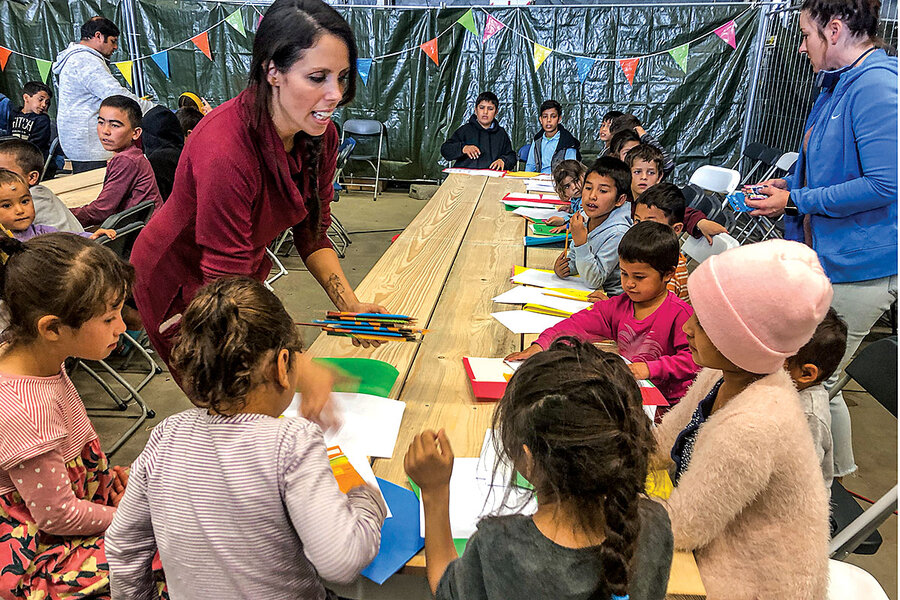
It’s not hard to find the small schoolhouse in the middle of a hangar that used to house C-130 cargo planes. Dozens of children jostle in a disorderly line at the entrance to their classroom, cordoned off from the rest of the cavernous space with Army green tarps hung on chain-link fences.
Like tiny clubgoers, they have ink stamps on the back of their hands. Volunteers dole out backpacks filled with goodies, bought with thousands of donations from U.S. families living in Germany. The stamps are to make sure each child just gets one of them.
As a couple of girls hit the line again, a volunteer sees their hand stamps and turns them away. “Nice try, though,” she says, with a nod of admiration for their hustle.
Inside the classroom, a bedsheet serves as a projector screen for students seated at desks made of two-by-fours laid over traffic barriers. Jessie Bledsoe, a military spouse, volunteer, and teacher of English as a second language, stands at the front of the class. Some 60 children count to 10 in English. Once the task is accomplished, they erupt in cheers.
“How old are you?” Ms. Bledsoe asks one girl. “I’m 10,” she says. More cheers.
The classes were the brainchild of Ahmad Faizi, a former school principal and interpreter for U.S. forces in Kandahar, who is now living in the tents with his wife and baby. “As a refugee, you don’t have much else to do. So I said, ‘Let me get this going.’ We’re busy, the day goes faster, and we get to see kids learning.”
He knew just how to spread the word. “We started with six kids and got them reading really loudly. Parents heard that and said, ‘Oh, there’s a school going on.’”
Now 1,000 women and children are showing up every day for classes that run every hour, says Ms. Bledsoe, who teaches 10 hours a day.

“We just thought of things they really needed to learn so that when they first introduced themselves at their new schools in America, they could have confidence,” she says.
Mr. Faizi’s first experience running a school was back in 2001, before the U.S. ousted the Taliban from power. “I bought every student a turban,” he says. “We started with the Islamic stuff, so when the Taliban came, they would see everybody studying Islam. They’d be happy and get out. Then we could do our own things – Pashto, English, art.”
Before the Taliban toppled the Afghan government this summer, Mr. Faizi was working multiple jobs, including as a security director at the airport. This gave him a chance to escape. At one point he brought his wife and their newborn to the airport, telling authorities they needed more women to do security pat-downs. “Then we got on a plane,” he says.
The Taliban takeover has been hard for him, he notes, tearing up. “We had a proper country for a long time.” He plans to go to Long Island, New York, and become a teacher. “But if Afghanistan ever needs my support again,” he says, “I’d go back.”
With so many families being evacuated to Ramstein, military officials have had to deal with a variety of health care needs – none more pressing than the birth of children. More than 200 of the Afghans flown out of Kabul were pregnant, and some 40 babies have been born on the base since then. Their arrival has often taken place in a makeshift maternity ward on a basketball court in a converted gym.

Among those helping out with the deliveries has been Maj. Suzanne Stammler, an Air Force obstetrician who was brought to Ramstein from her base in England.
“There are very young ladies who have had many, many babies, and I know that is a bit out of my comfort zone,” says Dr. Stammler, who notes that it is not unusual for some of the women to have had 10 children.
Accustomed to caring for Western patients, she has struggled with some of the cultural differences she has encountered. When she sees women here, their husbands sit right beside them – whether the wives want them there or not.
“The male is definitely the driver in terms of discussions,” Dr. Stammler says. “It’s hard for me as a provider who has taken the Western role of talking directly to women and making sure they’re safe.”
She recalls one visit in which the family spoke a less common Afghan dialect, so there were two male interpreters on hand. “The husband was very aware of this stuff, really answering questions, so that gave me reassurance. But I don’t think I’ve ever seen so many gentlemen in one room interested in birth control and menstrual cycles.
Then there have been the cases of assault. Dr. Stammler tells of a woman who came to see her wearing leg braces. “She said she’d had polio, like it was nothing.” The woman was also 27 weeks pregnant, living in a tent, and said she had been abused by her husband. “She said, ‘I don’t want to be with him anymore.’”
Dr. Stammler summoned a social worker, a therapist, and a sexual assault counselor. “Luckily the [unborn] baby was fine, but you knew the risk was significant,” she says. “We didn’t have any doubt that she was desperate.”
The woman had fled Afghanistan with her mother and sister as well. “We got them on a flight, and made sure her husband wasn’t there for it,” Dr. Stammler says. “I wouldn’t be able to live with myself if I didn’t take that intervention. But was it the right one?”
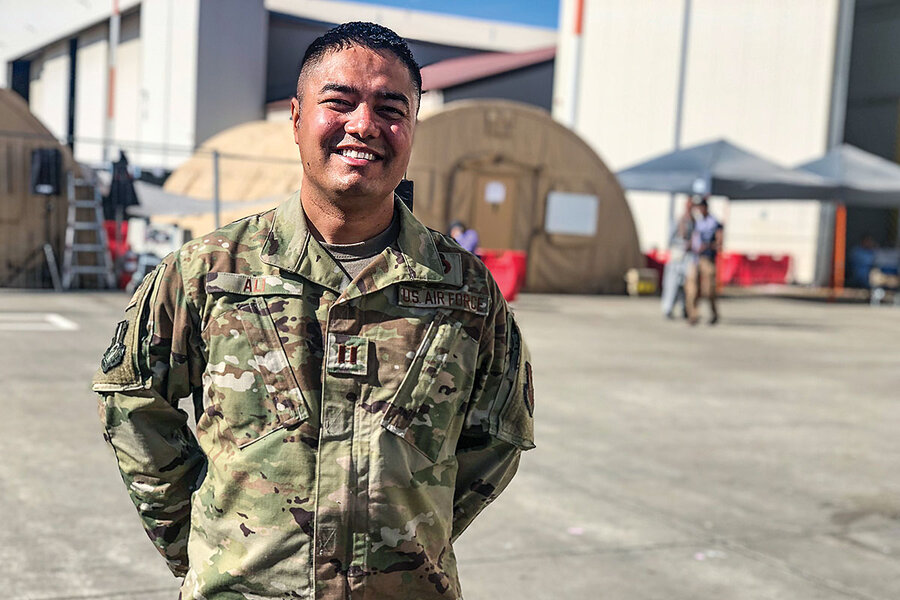
Capt. Mir Ali leads a call to Friday prayers as his song echoes out of loudspeakers across the tent city here. He hands out prayer rugs – some 600 were bought by the U.S. military from local vendors when the evacuees started arriving – to latecomers who are still standing in line for lunch when the services begin.
The Afghans are “grateful, deep down, to be away from a place where they were living in fear of persecution,” he says. But they are grappling with regrets, too. Many have left home, never to return, and have family members still in Afghanistan.
“There’s fear – whether their wives and children are alive, whether their family has access to food, shelter, and clothing. They’ve lost touch with them,” Captain Ali says.
There’s also uncertainty about their journey from here. In early September, the Biden administration halted all flights of Afghan evacuees to the U.S. after several arrivals from Ramstein were diagnosed with the measles. Those flights have since resumed. Now the White House is hoping to speed the transfer of evacuees off bases, including through a program, announced in late October, to pair Americans with Afghan arrivals and help neighborhoods create “sponsor circles.”
The prolonged stay of the evacuees here has taxed resources. Military personnel tried to find enough space heaters to warm the tents as the cold weather approached. Unable to do that, they pushed tents together, with one heater for every two dwellings.
They have made other accommodations as well. They put Wi-Fi in the hangars, so evacuees could reach out to family back home, and trucked in rows of donated German biergarten tables and benches, along with kettles, so they could gather for tea.
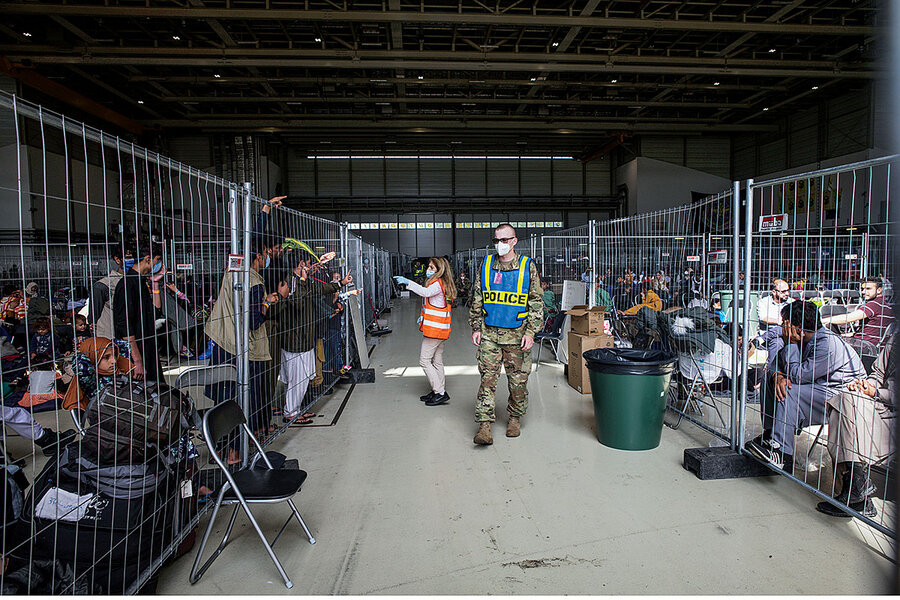
But drinking tea is something Afghans do with their families, and “though it’s a source of comfort,” Captain Ali says, “you take that familial piece away, and it’s a reminder of loss.”
Captain Ali’s journey to Ramstein was circuitous in its own way. He enlisted in the military at age 20 after dropping out of college, “not even knowing what the role of chaplain was.”
He’d planned on serving for four years, but after the 9/11 attacks he decided to stay in. His friends knew he was Muslim and were asking him questions about his religion – answers that he didn’t have. “That piqued my interest in learning about my faith.”
He earned a Master of Divinity at the Claremont School of Theology, a United Methodist seminary in Southern California that had a partnership with an Islamic institute.
Today he is one of only five imams in the U.S. Air Force. Having arrived at Ramstein with his family in June, he now works out of a chapel on the base that serves as a Christian church, a Jewish temple, and an Islamic mosque as he counsels the Afghan refugees.
Following the Friday service, Captain Ali says he is thankful he was sent to the base in time to work with the new arrivals.
He is able to counsel them that, however wrenching their journey might be, they are moving forward. “God tells us that with forward motion comes progress,” he says. “I try to help them understand that this is one step towards something better – something great.”

Communists face crackdown in Russia, upending old balance
Political loyalties are tested when ruling parties face pressure. Russia’s Communists have benefited from the Kremlin’s carefully crafted system but are alleging fraud – and facing consequences.

- Quick Read
- Deep Read ( 6 Min. )
Russia under President Vladimir Putin is increasingly cracking down on critics, and its newest target is the Communist Party. Long tolerated as a voice of opposition in the Kremlin’s carefully crafted “managed democracy,” the Communists called out alleged electoral fraud during last month’s parliamentary elections that they said cost them several victories. Now they are facing the consequences.
During rallies they attempted to stage in Moscow, party members and other protesters were arrested. One veteran left-wing dissident, Boris Kagarlitsky, was jailed for 10 days for posting on social media about Communist protest rallies that he says he didn’t know were prohibited. “To be arrested, tried, and convicted for something that just didn’t happen is a new thing, at least in our times,” he says. “This kind of political repression is new and a worrisome omen for the younger generation.”
The state backlash is unprecedented in the post-Soviet experience, and threatens to upend two decades of Putin-era political stability. Communist Party leaders have much to lose by pushing back against the status quo, but many rank-and-file members demand that they do. They lament they will never make political headway if they don’t.
Communists face crackdown in Russia, upending old balance

Boris Kagarlitsky, a veteran left-wing dissident, holds the distinction of having been a political prisoner under the regimes of Leonid Brezhnev and Boris Yeltsin. Now he can add President Vladimir Putin to that list. He’s just been released after a 10-day stint in a Moscow detention center for posting a link to a Communist Party statement alleging electoral fraud during last month’s parliamentary elections.
Mr. Kagarlitsky had been in Siberia working as a political strategist for a prominent Communist candidate for the State Duma, Russia’s lower house of parliament. He returned to the capital to find that the pro-Kremlin United Russia (UR) party had swept all the city’s constituencies. That was in defiance of exit polls and votes counted at polling stations, after tens of thousands of unverifiable “electronic votes” appeared and decisively reversed results.
A veritable encyclopedia on the subject of Russian electoral dirty tricks, Mr. Kagarlitsky says he has never seen fraud at this level. “What happened in Moscow was simply theft on a grand scale,” he says. “It testifies to how terrified Russian authorities are, even of the permitted electoral system that they created, that they would do this.”
The independent election watchdog Golos estimates that at least 78,000 fraudulent ballots were filed through the new system of electronic voting in Moscow, denying the Communist Party (KPRF) several wins. Now the party, which has long been tolerated by the Kremlin as a voice of opposition, is fighting back.
While some rank-and-file members want them to push harder if they ever want to make political headway, their nascent protesting has resulted in a decisive wave of official repression. The backlash is unprecedented in post-Soviet experience and threatens to upend two decades of Putin-era political stability.
A new kind of crackdown
Mr. Kagarlitsky, a well-known scholar who belongs to no political party, was arrested Sept. 30 when he arrived at the Higher School of Social and Economic Sciences, where he lectures. He was subsequently sentenced for sharing banned content on social media. He maintains he posted what he thought was a routine political critique about the voting fraud and linked to a KPRF statement that mentioned party rallies. He says he didn’t know the rallies had been prohibited by authorities.
“To be arrested, tried, and convicted for something that just didn’t happen is a new thing, at least in our times,” he says. “This kind of political repression is new and a worrisome omen for the younger generation.”
Russia under Mr. Putin is increasingly cracking down on critics. Over the past year, authorities have cast an ever-wider net, first arresting anti-corruption campaigner and longtime Putin rival Alexei Navalny, who was poisoned last year, and then closing down all of his political organizations. Many civil society groups have been branded “foreign agents,” some forced to close their doors. Independent media outlets have been similarly hounded.
Now it appears the turn of the officially permitted opposition parties, whose different viewpoints can generate a range of debate, especially on domestic policy.

Until recently a Kremlin-authored system of “managed democracy” – which functions as long as the UR majority remains unchallenged and opposition parties accept their subordinate positions – has maintained a semblance of political legitimacy in the Putin era.
The KPRF, with 150,000 members including 40,000 youths, is Russia’s second-largest party and the only major one with independent historical roots in Russia, while most others have been artificially created by the Kremlin. The KPRF won 19% of the votes in the September election, up about 5% from its previous tally in 2016. By contrast UR, which had been running at around 30% in national preelection polling, won around 49%, about 5% below its previous total.
The KPRF claims it was robbed of several constituency victories – something that has never happened on this scale before, prompting the protests. In Moscow the party tried to organize two public rallies before they were violently dispersed. Both were declared illegal by city authorities.
When the Communist Party’s Duma deputies attempted to hold a public “meeting with voters” – considered an inviolable right – about 180 activists were arrested, including six elected officials. Police laid siege to a building where the party’s lawyers were preparing a legal challenge to election results, nearly preventing them from meeting a filing deadline for their lawsuit.
Nikolai Zubrilin, an elected KPRF deputy of the Moscow city council, has been arrested twice since the election and says the crackdown shows the vulnerability of authorities as more Russians begin to doubt their legitimacy. “Elections in Russia have never been clean,” he says, “but I have never seen abuses like this.”
The “electronic voting” system was introduced over serious objections by the KPRF and other critics in eight Russian regions, including Moscow, shortly before the race. Authorities say that about 2 million people registered to use the system, but critics say there are no voters’ lists to corroborate that or even any means to trace the votes, much less stage a recount.
“European courts have banned this type of voting as non-transparent,” says Yaroslav Listov, a newly elected KPRF Duma deputy. “Instead of some procedure that can be verified, elections have basically become an act of faith. We have absolutely no means to check the voting patterns.”
The KPRF says it has launched about 250 lawsuits in connection with alleged election violations, and a coalition of losing candidates from several opposition parties is pushing for the voting system to be banned for future elections. Moscow election officials say their own investigation found no evidence of fraud, and the results have since been certified.
Mikhail Lobanov was a Duma candidate for Moscow’s Kuntsevo district and supported by the KPRF. He was ahead by 12,000 votes when paper ballots had all been counted on election night. Then 20,000 electronic votes suddenly materialized in favor of his UR opponent, state TV presenter Yevgeny Popov. Mr. Popov won by 8,000 votes.
“Something needs to change”
Mr. Lobanov says the KPRF has been trapped by Kremlin design into a predetermined place within the existing system and, unless it moves more decisively into the streets to stage more convincing forms of peaceful resistance – as happened when millions of Russians protested against election fraud a decade ago – it will lose relevance with Russian voters.
In fact, within the KPRF some members have lamented a too-passive reaction by leader Gennady Zyuganov to the results, and are pushing against their leaders’ “business as usual” relations with authorities.
“If [the party] wants to survive as an opposition force, the KPRF needs to take action to maintain the trust of the people who voted for it,” Mr. Lobanov says. “That’s hard for party functionaries, who are accustomed to getting along with authorities and enjoying the perks of their jobs. But ordinary members, especially the younger ones, are getting more radical. Something needs to change.”
Mr. Kagarlitsky says Russian authorities are scared and are intensifying the crackdown against a party they had tolerated for the past two decades because they know Russian history. Top-down, bureaucratic states of the type Mr. Putin has reinvented tend to collapse, often quickly and unexpectedly, he says, as has happened twice in a little over a century – after the fall of the Russian Empire in 1917 and the collapse of the USSR in 1991.
“The Russian public has a very left-wing orientation, so time favors the left,” he says. “The liberal opposition might have been in a position to take full advantage of the Soviet collapse 30 years ago, but they’ve squandered that opportunity. Now the KPRF, for all its flaws and hesitations, is the main repository of left-wing ideas and strong-minded left personalities on our political landscape. No wonder the authorities are reacting in such a terrified manner – much more than seems rational – to the party’s gains in the last election.”

Rising waters set stage for more sea walls in US future
In past ages, conquering the seas meant venturing out toward known or unknown lands. Humans still do that, but today’s rising focus is on a defensive game – guarding coastal communities from storms and floods.
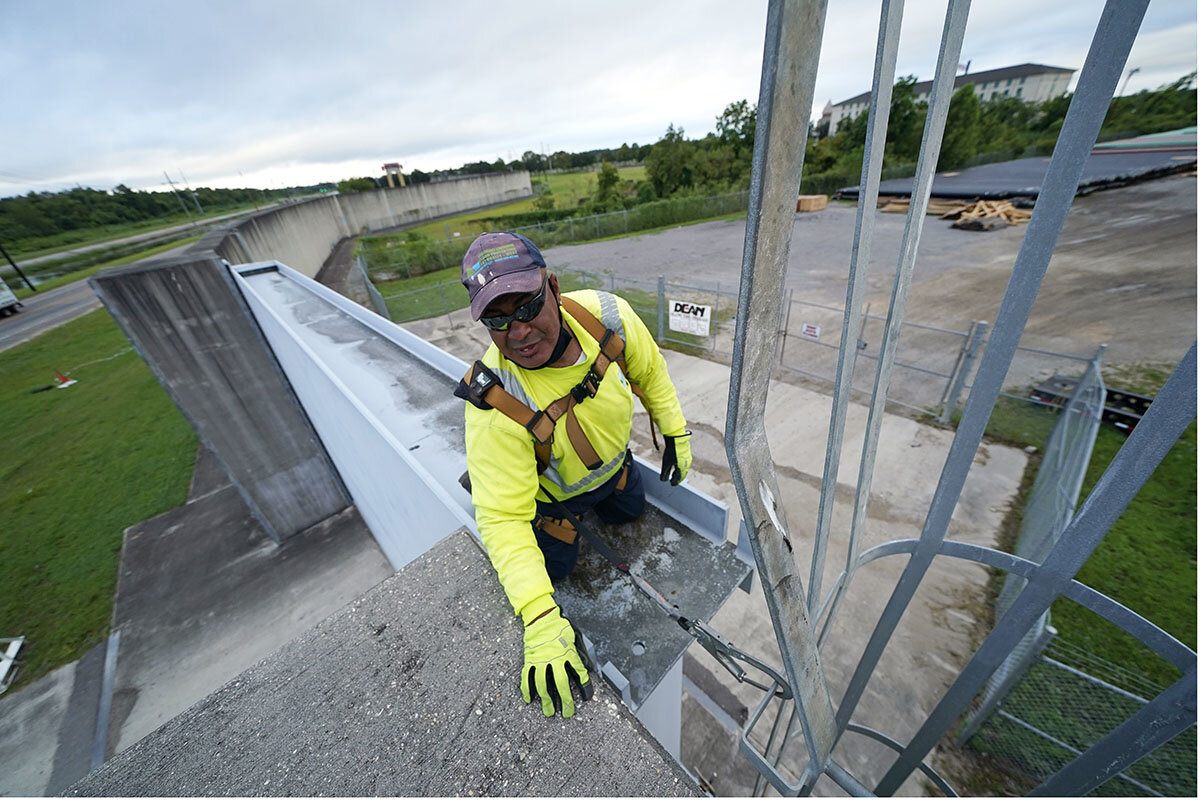
- Quick Read
- Deep Read ( 6 Min. )
-
By Xander Peters Special correspondent
When Louisiana’s levee system held firm in August, protecting New Orleans residents from the risk of significant flooding during Hurricane Ida, it bolstered the notion that engineered defenses are a feasible way to mitigate some of the harshest coastal impacts of climate change.
The complications are myriad – from challenges with funding and public support to questions of whether human engineering simply alters threats rather than removes them.
Yet in the minds of flood-risk experts, sea walls work – most of the time. U.S. coastal communities and the federal government have begun recognizing the changing risks.
In Charleston, South Carolina, city leaders endorsed a $2 billion federal proposal to build an 8-mile-long sea wall to protect the city’s historic district. In Miami, the Army Corps of Engineers is researching the feasibility of an estimated $8 billion, 13-foot-high sea wall. Near New York City there’s a similar proposal that would cost up to $119 billion. And Texans are weighing a so-called Ike Dike system to protect Houston and the surrounding area.
William Merrell, an expert on coastal defenses at Texas A&M University at Galveston, says, “These large barriers are just going to be part of how we adapt to rising sea level.”
Rising waters set stage for more sea walls in US future
When Hurricane Ida made landfall on Aug. 29, the storm’s fierce winds left fallen trees scattered across southeast Louisiana like lawn clippings, while its heavy rains and storm surge threatened severe flooding. But in New Orleans a sense of relief was palpable: The city remained largely dry.
Sixteen years to the day earlier, when Hurricane Katrina made landfall on Louisiana’s and Mississippi’s Gulf Coast, the aftermath was different. More than 1,800 people died due to structural failures in the region’s levee system, and tens of thousands of people who hadn’t evacuated found themselves flood bound in their New Orleans homes.
Why wasn’t Ida equally catastrophic?
Residents and experts alike say one big reason is the $14.5 billion in post-Katrina federal investment to expand and fortify the region’s levees and other flood walls. The effort worked. Where Katrina left a staggering $179 billion in damage in today’s dollars – making it the costliest U.S. weather disaster – this time levees staved off the worst of Ida’s predicted 12-foot surge. The result may be to confirm a model of flood preparedness that will be increasingly followed nationwide.
“It’s definitely a proof of concept,” says Nicholas Cali, the regional director of Southeast Louisiana Flood Protection Authority-West, which plays a role in maintaining the region’s flood risk management system. The system went “above and beyond what, I think, people had anticipated.”
Simply put, the success of southeast Louisiana’s levee system reinforces the notion that constructing sea walls is a feasible way to mitigate some of the harshest coastal impacts of climate change.
Proposals rising from Gulf Coast to New York
The complications are myriad – from challenges with funding and public support to questions of whether human engineering simply alters threats rather than removes them. Even well-designed systems can ultimately fail.
Yet in the minds of flood-risk experts, sea walls work – most of the time. U.S. communities from the East to the West and Gulf Coasts have begun recognizing the changing risks and are pursuing defensive strategies, even as the federal government proposes action of its own. For many localities, it feels like the only choice.
In Charleston, South Carolina, sea levels have already risen by 10 inches since 1950, according to estimates from the National Oceanic and Atmospheric Administration. Earlier this year, Charleston city leaders endorsed a $2 billion federal proposal to build an 8-mile-long sea wall to protect the city’s historic district. In Miami, where sea levels are expected to rise by 15 inches in the next 30 years, the Army Corps of Engineers is researching the feasibility of an estimated $8 billion, 13-foot-high sea wall. Near New York City, where Hurricane Sandy created a 13-foot storm surge in 2012, a similar proposal up to $119 billion would build a massive sea wall between Sandy Hook, New Jersey, and Queens, New York.
“These large barriers are just going to be part of how we adapt to rising sea level,” says William Merrell, a professor at Texas A&M University at Galveston. Dr. Merrell is credited with being the first expert to propose the idea of building what’s become known as the Ike Dike, an estimated $26 billion project that would wall off the region from Galveston up to the shipping ports and refineries of Houston.

Hurricane Ike tore into the Texas coast in September 2008, razing homes on Bolivar Peninsula when it made landfall due to a 20-foot surge in some areas. Nearby Galveston, while not spared from damage, was mostly still intact thanks to its own line of defense – a sea wall.
That wall traces its roots to a devastating 1900 Galveston hurricane that cost as many as 6,000 lives. Many storms later, it’s in part the reason the city of Galveston still stands today.

US Army Corps of Engineers
The promise and the challenges
Building walls to protect humankind from the unforgiving seas is an ancient idea. In the first century B.C., Herod the Great of Rome ordered the people of Caesarea – in modern day Israel – to build an artificial sea wall and harbor that would serve as a trade port, by filling wooden barges with concrete and sinking them into the shallow water.
The process worked, until Earth’s geology decided otherwise. (Unbeknownst to the Romans, there was a fault line under the harbor.)
For all their potential, engineered barriers aren’t a fix-all solution for rising seas, some researchers say.
A recent study by researchers at Stanford University’s Natural Capital Project, published in the journal Proceedings of the National Academy of Sciences, demonstrated how “gray” approaches to combating sea level rise – human-made infrastructure, like sea walls – can create unintended consequences for areas outside protected zones. The researchers used San Francisco Bay, where hydrodynamics differ from an open coastline, as their primary example. And by dividing the shoreline into small pieces, the researchers were able to model changes in the flood depth, coupled with the theoretical economic impacts. Their findings were concerning.
“Our modeling showed that communities around the Bay could face additional flooding” after the addition of one large sea wall to the bay – with an estimated $723 million in added flood damage from just one high tide during spring, says Anne Guerry, a lead scientist in the study and chief strategy officer with the Natural Capital Project.
After all, Dr. Guerry says, the water “has to go somewhere. It’s going to flow somewhere else.”
The researchers’ findings are also applicable to closed bay water systems elsewhere in the U.S.
“There needs to be a regional conversation about who wins and who loses,” Dr. Guerry says. “Instead of making flooding worse for overburdened communities, let’s take a more regional approach where we think about using a combination of gray … and green infrastructure – natural systems like marshes and oyster reefs, and sea grasses and various types of coastal habitats.”
Charting a future
Climate-mitigation thought leaders find themselves daydreaming about what that future might look like, and what it will take to maintain functioning coastal societies.
In Dr. Guerry’s view, the nuances of combining human-made and natural mitigation elements will increasingly become common knowledge – including plans to allow contained flooding inland rather than walling the sea off. She envisions a world where new communities are developed, but only after hard conversations are had about managed retreat.
For Dr. Merrell, the construction Texans began on Galveston’s sea wall in 1902 will continue in new forms. First the Ike Dike. Then perhaps an extension of it farther down the Texas coast. Eventually, Dr. Merrell suggests, a series of climate-adaptive sea walls will dot their way along the Gulf and up the Atlantic and Pacific coasts.
“I think what you’ll see is a concentration of wealth and population behind these barriers, and you’ll see relatively less building outside,” Dr. Merrell says. “It’s more like the medieval idea of you having this kind of walled in city and everybody runs in when the hordes come charging.”
In the meantime, it’s about instilling confidence in the folks who are already behind the walls, says Mr. Cali, the SLFPA-West’s regional director. “The flood wall’s great. It worked. The levees are great. They worked. But every foot of real estate you put between that flood wall and the Gulf of Mexico makes it work better. It extends the life,” he says, of the protection we currently have.

US Army Corps of Engineers

Points of Progress
Conserving species and specimens, from tuna to trees
In our progress roundup, the prospect of losing something unique is motivating action – whether it’s saving a tree connected to St. Francis of Assisi, or the sought-after tunas that end up on dinner tables around the world.
Conserving species and specimens, from tuna to trees

For the wildlife featured this week, progress is measured in terms of preservation. But newness can represent advancement, too, as shown by the first American woman to break into a male-dominated profession.
1. United States
The Milwaukee Bucks are bringing on Lisa Byington as the team’s full-time TV play-by-play announcer, making her the first woman in this role for any major men’s sports franchise. Ms. Byington has a long career in sports broadcasting, both as a sideline reporter and play-by-play announcer. In March, she became the first woman to handle play-by-play for an NCAA men’s tournament game. More recently, she could be seen on NBC calling men’s and women’s soccer matches at the Tokyo Olympics. Other NBA teams have created broadcasting teams of women for single games. After the Toronto Raptors were the first to do so in March, a Sacramento Kings game featured female and nonbinary on-air talent. “I understand the groundbreaking nature of this hire,” Ms. Byington said. “I applaud the Bucks for taking the first steps toward making hires like this more of the norm in the NBA. Because it’s time.”
ESPN, The Washington Post

2. Colombia
International initiatives are helping Afro-Colombian communities formalize sustainable gold mining operations. Thousands of traditional miners in Colombia’s Chocó region have long engaged in small-scale, nonmechanical gold mining with low environmental impact. However, the country holds local community members to the same legal, technical, environmental, and labor standards as massive mining corporations – creating unwieldy bureaucratic barriers for small-scale miners. Because of these barriers, almost all artisanal miners go unregistered, meaning they can’t open bank accounts and are forced to sell gold on the black market. This framework also enables multinational companies to claim mining rights in Indigenous and Afro-Colombian territories.
American and Swiss projects are working to help miners keep up with the administrative demands and improve incomes. The Better Gold Initiative incentivizes formalization by paying miners a premium of $1 per gram for meeting environmental and social criteria, and by connecting participants with major players in the international gold trade, such as Cartier. The Swiss project, which currently works with about 1,400 miners in Chocó, hopes to expand to 3,000 miners and export 1 metric ton of responsibly produced gold annually. From 2015 to 2021, the U.S. government’s Oro Legal program formalized 146 mining operations and produced nearly $200 million in legal gold sales. It also established the now-independent CORCRESER, or the Corporation of Regional Service Centers, to continue assisting miners with the formalization process and professional training.
Mongabay
3. Italy
Italy is protecting thousands of ancient trees across the country, preserving their cultural history and ecological benefits. Anyone who damages one of the striking, storied trees – known as monumental trees – can incur fines of up to $117,000. Federal law first addressed these living monuments in 1939, protecting them as “immovable things that have remarkable characteristics of natural beauty.” Those laws have since expanded to honor monumental trees as drivers of biodiversity, rather than simply as aesthetic landmarks. Today, a collapsed or rotting branch would also be protected, and left to nourish the tree’s microhabitat. “It’s actually a cultural shift because, nowadays, we propose to preserve these trees for something that in the past were considered defects,” said ecologist Livia Zapponi.

More than 3,500 monumental trees have been added to the national registry since 2013, chosen, among other reasons, for their rarity, cultural significance, and ecological value. The roughly 22,000 specimens include an 800-year-old cypress tree located in a Franciscan convent in northern Italy. Like many monumental trees, it comes with a legend: St. Francis of Assisi is said to have buried his walking stick in the ground and commanded it to grow, and now visitors collect fallen cypress cones in hopes of planting their own blessed trees.
National Geographic
4. Nigeria
Small nonprofits are helping improve maternal health in rural Nigeria. United Nations agencies estimated that 23% of global maternal deaths in 2017 occurred in Nigeria, Africa’s most populous country, with more than 900 deaths per 100,000 births. These issues are especially pronounced in rural areas, where communities often lack health facilities or the ability to afford treatment. Hacey Health Initiative’s Project Agbebi has trained community birth attendants and distributed more than 50,000 free birthing kits – containing sterile blades, gloves, and other essentials – and over 100,000 mosquito nets to help prevent malaria. Alabiamo Foundation administers basic prenatal care and provides new mothers with supplies, such as baby clothes and food. The project prioritizes family planning education and building trust with local midwives, who may view the nongovernmental organization workers as a threat to their livelihoods. “[The initiative is] really helping us,” said Oke Jaqueline, a beneficiary of the program in the Makoko-Sogunro community. “A lot of time we don’t bother to go to clinic, they come to us to take care of us.”
Pulse

World
The conservation status of several commonly fished tuna species has improved, according to the Red List assessment. The Red List, compiled by the International Union for Conservation of Nature (IUCN), is considered the gold standard for measuring the extinction risk of plant and animal species. In 2011, conservationists warned over half of tuna species were at risk of extinction, due to overfishing. The last decade saw strict quotas implemented, with strong policing of illegal fishing. The 2021 report showed signs of recovery for four popular tunas: The southern bluefin tuna moved from critically endangered to endangered, the Atlantic bluefin tuna shifted from endangered to least concern, and both the albacore and yellowfin tuna moved from near threatened to least concern.Pressures on marine species continue to grow, warn IUCN scientists, and some tuna stocks are still in decline. “These Red List assessments are proof that sustainable fisheries approaches work, with enormous long-term benefits for livelihoods and biodiversity,” said Dr. Bruce Collette, chair of the IUCN Species Survival Commission’s Tuna and Billfish Specialist Group.
Euronews, BBC

Other headline stories we’re watching
(Get live updates throughout the day.)The Monitor's View
Israel extends a hand to Israeli Arabs
- Quick Read
- Deep Read ( 2 Min. )
-
By the Monitor's Editorial Board
Israel took a major step this week toward treating its non-Jewish citizens, who make up a fifth of the population, as equal members of its democracy. The ruling coalition’s Cabinet approved more than $10 billion in spending over five years to uplift Israeli Arabs, from fighting a crime wave in their communities to reducing a wide education gap between Arabs and Jews. This financial corrective to the historical neglect of Israel’s Arab citizens reflects a plan by coalition leader Yair Lapid to heal “the crisis within us.”
If the plan is approved by parliament next month as expected, it could also set a template for ways to ease tensions between Israel and Palestinians living in the West Bank. It also reflects the new politics of Israel, represented by a 4-month-old coalition under Prime Minister Naftali Bennett.
The spending plan may help young Arab Israelis become more attached to Israel, not as a Jewish state but as a democracy with equal rights for all. Greater equality in Israel might help all people and nations in the Middle East to see each other as equals.
Israel extends a hand to Israeli Arabs

Israel took a major step this week toward treating its non-Jewish citizens, who make up a fifth of the population, as equal members of its democracy. The ruling coalition’s Cabinet approved more than $10 billion in spending over five years to uplift Israeli Arabs, from fighting a crime wave in their communities to reducing a wide education gap between Arabs and Jews.
This financial corrective to the historical neglect of Israel’s Arab citizens reflects a plan by coalition leader Yair Lapid to heal “the crisis within us.” Even though Israel enjoys rising prosperity, more than half of Arab Israelis still live under the poverty line and mostly in separate enclaves. A study in 2019 found that “a Jewish student in Israel can graduate from high school without ever having met a single Arab student in person, and the reverse is also true.”
If the plan is approved by parliament next month as expected, it could also set a template for ways to ease tensions between Israel and Palestinians living in the West Bank. (Many Israelis refer to Arabs living within Israel proper as Palestinians.)
It also reflects the new politics of Israel, represented by a 4-month-old coalition under Prime Minister Naftali Bennett. The coalition not only includes parties from the left and right but also the first independent Arab party in a governing coalition in Israeli history. The Islamist Raam party holds enough seats in the Knesset to nudge the coalition to approve the spending package. Party leader Mansour Abbas says the money “will go a long way to close the gaps between Jewish and Arab sectors.”
Another reason for the spending package is a drive to reconcile residents in cities where Arabs and Jews live close to each other. Racial riots between the two groups broke out last May during Israel’s war with Hamas in Gaza.
The main purpose of Israel’s diverse coalition, says Mr. Lapid, is to “find the shared good.” The spending plan may help young Arab Israelis become more attached to Israel, not as a Jewish state but as a democracy with equal rights for all. “The government will do everything it can to unite every part of Israeli society,” said Mr. Lapid.
Greater equality in Israel might help all people and nations in the Middle East to see each other as equals.

A Christian Science Perspective
Each weekday, the Monitor includes one clearly labeled religious article offering spiritual insight on contemporary issues, including the news. The publication – in its various forms – is produced for anyone who cares about the progress of the human endeavor around the world and seeks news reported with compassion, intelligence, and an essentially constructive lens. For many, that caring has religious roots. For many, it does not. The Monitor has always embraced both audiences. The Monitor is owned by a church – The First Church of Christ, Scientist, in Boston – whose founder was concerned with both the state of the world and the quality of available news.
What really defines us
- Quick Read
- Read or Listen ( 4 Min. )
-
By Thomas Mitchinson
At times, an illness or injury may seem inextricably linked to our very identity. Recognizing that as God’s children we are so much more than a physical body frees us from defining ourselves by problems and opens the door to healing.
What really defines us
When we’ve been facing a physical or mental challenge, we may feel as if the ailment has become our identity. But this is not who we are.
Increasingly, public thought is recognizing that any illness we may face does not define us. “I am not my disease,” Patrick McNamara, Ph.D, posted at one time. He continued, “...perhaps one of the best things we can do for one another [is] to remind one another that we are not reducible to a disease....”
We do not need to accept that any disease or problem defines us. But this is more than just disassociating a material problem from a material view of ourselves. Instead, it’s letting our thought be consistently oriented to fully accepting that we are so much more than what a physical body – a sick body or even a healthy one – presents. It’s starting from a completely different basis – that we are actually wholly spiritual, complete children of God, here and now.
Based on the Bible, Christian Science teaches that man (the true, spiritual identity of each of us) is made in the image and likeness of God, Spirit. God is completely good; God did not create sickness and doesn’t send it. Therefore, each of us is in reality the manifestation of all the qualities of God, including health, strength, agility, and purity. This expression of divine qualities defines us.
Mary Baker Eddy, the discoverer of Christian Science, came to this conclusion after deeply studying the Bible, searching for the truth about God and man, and seeing how this understanding of God and His creation heals. She wrote in her main work, “Science and Health with Key to the Scriptures”: “All reality is in God and His creation, harmonious and eternal. That which He creates is good, and He makes all that is made. Therefore the only reality of sin, sickness, or death is the awful fact that unrealities seem real to human, erring belief, until God strips off their disguise” (p. 472).
The fact that each of us is created as God’s spiritual offspring is the understanding that Jesus confirmed over and over in his healing ministry. When he and his disciples saw a man who was blind from birth, the disciples tried to figure out whose fault it was. They appeared willing to accept that this condition, this “disguise,” defined the man. But Jesus stated, “Neither hath this man sinned, nor his parents: but that the works of God should be made manifest in him.” This understanding cleared away the belief in the reality of an illness and the man’s sight was restored (see John 9:1-7).
Jesus demonstrated the Christ – the healing truth that each of us is actually God’s expression or reflection. The eternal Christ, Truth, strips off every disguise – such as sin, fear, discouragement, lack, mental illness, or physical disease – by showing that these evils were never God-created or God-sanctioned. This divine action, transforming thought, reveals the spiritual man of God’s creating – holy, perfect, well, and invulnerable.
During part of my early high school years, I awoke ill each morning. It was quite an ordeal to dress and go to the bus stop. I never spoke about this to my parents because it didn’t seem serious, just very annoying. In this instance, I also felt I wanted to learn to demonstrate the healing power of prayer for myself. I had a long bus ride every morning and spent that time praying – confirming in thought that no illness or fear could hide the perfect selfhood I had as God’s child. This time of spiritual discovery included silently singing hymns to myself and feeling God’s love.
By the time I arrived at school each day, I was well. This continued until the Christly understanding of God and my true identity completely stripped off the disguise of illness. Not only was I completely healed, but I also felt so much closer to God.
This type of healing is available for all of us. As we understand our relation to the Divine as God’s beloved children, we awaken to God’s, divine Love’s, unceasing care, our inseparability from that Love, and the truth of our being. God continuously expresses perfection in His spiritual creation.
As we live from that basis, illness, fear, loneliness, disappointment, and so on don’t appear to be the defining measure of our lives. Instead, we see more clearly, and increasingly evidence, our true selfhood as God’s child – happy, well, loved, loving, and at peace.
Adapted from an editorial published in the Oct. 25, 2021, issue of the Christian Science Sentinel.

A message of love
Alpine vista
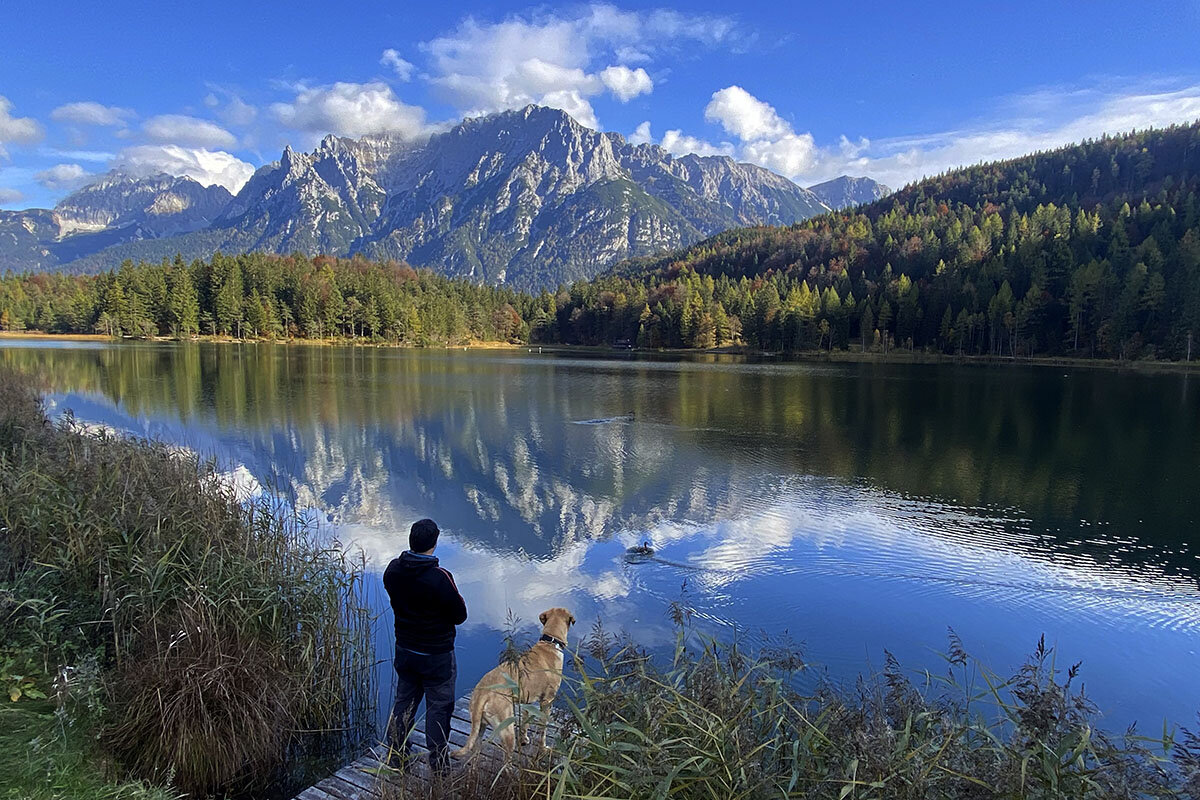
A look ahead
Thanks for joining us today. Come back tomorrow for an essay from a mom whose college-age son and his friends started a local political party – and asked her to be their candidate.



